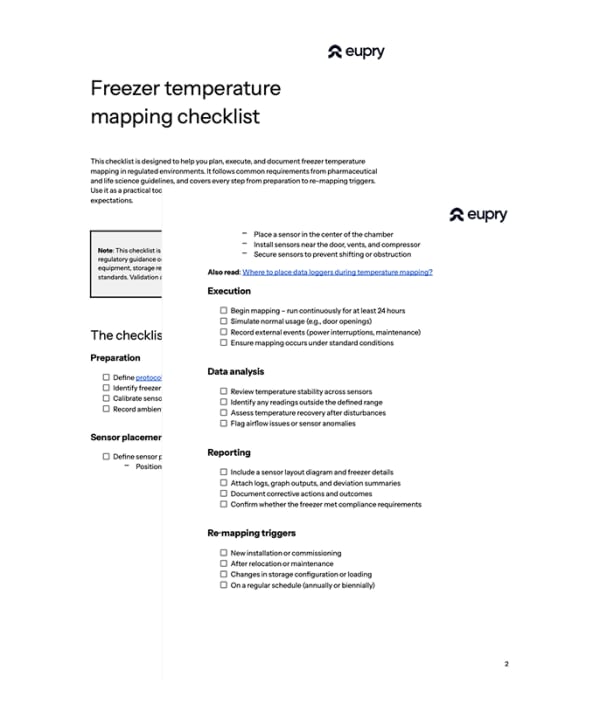Temperature mapping for freezers
How, why, and when?

Adam Hartmann-Kruckow
Everything you need to perform freezer temperature mapping in line with GxP requirements – from protocol setup to sensor placement.
A practical tool to structure your freezer mapping process

Note:
This guide is intended as a general aid and reference. It does not replace official regulatory guidance or internal quality protocols. Always adapt the steps based on your specific equipment, storage requirements, risk assessments, and applicable national and international standards.
Why freezer temperature mapping matters
Freezers are critical in many industries where temperature-sensitive products must be stored at consistent, ultra-low temperatures. This includes pharmaceuticals, life sciences, and food production.
Unlike standard refrigerators, freezers often operate at or below minus 20 degrees Celsius, with ultra-low freezers reaching minus 80 degrees or lower. These extreme temperatures introduce specific challenges that make precise temperature mapping necessary.
Freezer performance can be affected by frost accumulation, uneven airflow, defrost cycles, and prolonged door openings. These factors can create hot or cold spots that compromise product safety. Regulatory guidelines – including those from the World Health Organization and various good distribution practice frameworks – recommend temperature mapping to validate that temperature stays within the defined range under real operating conditions.
How to do mapping of a freezer: Protocol and placement
Before beginning a mapping exercise, define a clear protocol. Start by selecting a representative freezer – ideally one loaded to typical capacity. Determine how long the mapping will run (usually at least 24 hours) and at what interval data will be recorded (commonly every one to five minutes).
Next, decide where to place the sensors. A typical configuration includes data loggers in:
- Each corner of each shelf (top, middle, bottom)
- The center of the chamber
- Near the door, vents, and compressor (if accessible)
However, always apply a risk based approach to defining sensor placement.
Also read: Where to place data loggers during temperature mapping?
Use calibrated data loggers with a resolution appropriate for cold temperatures. Ensure that all probes are secured and not obstructed by stored items.
Run the temperature mapping under normal operating conditions. Keep the door closed except for any planned openings included in the protocol. Document any external influences, such as power fluctuations or high room temperatures.
Interpreting the results
Once data is collected, analyze the time series for temperature fluctuations, hot and cold zones, and deviations from the set point. Pay attention to how quickly the freezer recovers after any simulated door openings or defrost events.
Look for patterns that suggest airflow issues, sensor inaccuracies, or faulty seals. If temperatures fall outside acceptable limits – even temporarily – corrective actions may be required. This could include rearranging inventory, modifying shelf placement, or adjusting defrost settings.
Document all findings and include a summary that states whether the freezer met compliance requirements. If not, indicate what changes were made and whether re-mapping is needed.
When and how often to map
Freezer temperature mapping is typically performed:
- Before placing a unit into service
- After significant maintenance or relocation
- When internal storage configurations change significantly
- At regular intervals (annually or biennially) to confirm ongoing compliance
Any change that could affect temperature uniformity – such as a new defrost timer or door seal replacement – should prompt a new mapping cycle.
Also see: Comparison: Freezer temperature alarms for GxP
Best practices for freezer mapping checklist
- Use calibrated sensors with documented accuracy
- Place sensors evenly to capture spatial variation
- Run the test for at least 24 hours
- Simulate realistic usage conditions
- Include external and internal event logs
- Validate against the defined temperature range
- Document results clearly and store records securely
Also read: Full guide - temperature mapping in GxP
Learn more
Learn how to qualify and validate pharmaceutical freezers (ULTs and standard) under GMP/GDP – from IQ/OQ/PQ protocols to audit preparation. Find the full guide for ULT and freezer qualification and validation for pharma here.

Freezer temperature mapping checklist
A practical tool to structure your freezer mapping process.